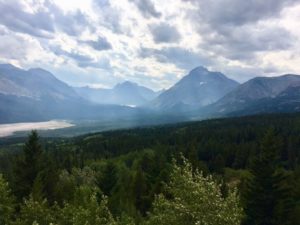
Silence. Lichen spreads between my fingertips like spider webs as the callousness of rock scratches against my hands.
It is the first day of WRFI’s Montana Afoot and Afloat course, and I just met my classmates for the next nine weeks. Giddy yet apprehensive about what was to come, I sat on a rock beside the windy river and wrote.
Often, one can feel alone when surrounded only by the elements, even when it seems counterintuitive. Logically, one can understand that he or she is never alone, for even the slightest breeze evokes thoughts of presence. Yet still, I felt somewhat alone — intimate with the surrounding community but detached from the people sitting fifty feet from my post.
During this odd moment of feeling alone, even in the midst of others, I encountered a pleasant spirit, yet my eyes were not what saw him. Instead, the plant beside me, acknowledging that I was too caught-up with the thoughts inside my head, brushed my shoulder to reawaken my senses. For in front of me, a little garter snake sat staring at my presence. Only about ten inches long, his yellow and brown figure waded towards me through the water, popping his head through the thick, algae-covered surface along the way.
As if to acknowledge my presence, he looked at me for about ten minutes, pondered a little bit, and then left to attend his snakely duties. Even for that brief moment that I met the little snake, I felt as though I had been visited — visited by a spirit who coerced me to stop for a while and observe the life before my eyes.
My interactions with critters during my WRFI journey did not stop there. On our group’s second day backpacking within the Scapegoat Wilderness, I met another teacher.
Around noontime, as the sun rose high in the sky on this second day, a deep tiredness arose from the depths of my feet and spread throughout my extremities. My mind, focused on moving one foot in front of the other as exhaustion spread, awakened upon hearing the word “succulent.”
A succulent in the Montanan alpine wilderness seemed unlikely to me, a girl completely unfamiliar with alpine ecosystems. Yet, I kept my mind and eyes open as our backpacking group traversed the wilderness. Suddenly, at ground-level, I saw what looked like a succulent — dark green, rice-shaped protrusions extending off the plant’s common stem, The plant’s semi-glossy exterior was reminiscent of a cactus’ skin — dark green but minus the spines. Its tough skin and short stature were indicative of dry environment adaptations for conserving water and resources. Undoubtedly, this plant exhibited all of the common features of a succulent.
Thus, I asked the group’s resident plant expert and fellow student, Karlyn, what it was, and she gleefully responded, “Bitterroot! The state plant of Montana!” How funny that a humble little succulent would be the state plant of an area characterized by its grandeur!
I envied the plant’s inconspicuous nature and wished that I could become it as my backpack grew heavier. Yet, although I was growing weaker and losing awareness of my surroundings, the bitterroot plants were not. Practically every time that I stopped to catch my breath and recollect, a bitterroot would be right alongside me on the trail; it almost seemed like they were my cairns guiding my hike, reminding me that it was almost over.
Unaware of it at the time, I was actually suffering from altitude sickness and severe dehydration on the hike, compounded by the fact that it was my “time of the month.” This shifted my body into “emergency-mode” making me feel exhausted, simultaneously hot and cold, and bone-dry. Focusing on the bitterroots’ presence allowed me to travel to camp without focusing as much on my physical pain and disorientation.
Yet, I feel like both the garter snake and bitterroots’ presence from the start of this backpacking experience to the end of it (due to being evacuated from the altitude sickness) was anything but a coincidence. The garter snake revealed himself to me at a time when I was afraid and apprehensive about what was to come. He taught me to observe what’s around me with my senses rather than just my pen and reminded me that I was far from alone, for I was surrounded by twelve of the best humans, my WRFI classmates and instructors.
On the other hand, the bitterroots inspired me to keep moving forward even when I felt like I could not. The bitterroot could preserve water and food, and, instead of buckling under the elevation, it was thriving. I had a lot to learn about this teacher of a plant regarding hydration, resource allocation, elevation, and acceptance; it knew its place and made the best out of what it was given.
Throughout the rest of my WRFI Afoot and Afloat course, I hope to mimic both the garter snake and the bitterroot’s wisdom for the sake of the group and myself. And, if I do happen to stray away from the trail again on this trip, I hope that the bitterroot and garter snake can guide me back to where I am supposed to be and allow me to express my appreciation for them in person.